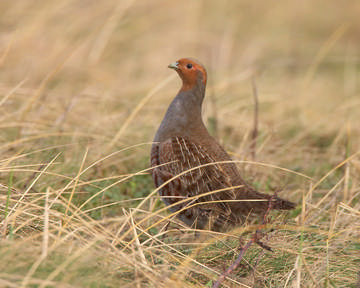
Grey Partridge © Richard Steel
As expected for a sedentary bird, there is not much difference between the breeding and wintering distribution of Grey Partridges. They appear to quit the eastern hills in winter, and there might be some altitudinal migration, as has been suggested also in Northumbria Winter Atlas. Even in the lowlands they will undertake small-scale local movements, and they were found in 42 tetrads in winter where there was no breeding season record, although not found in 67 where they had been present in a breeding season. Farmland made up the great majority of habitat records (88%), with 23% improved grassland, 12% unimproved grassland, 19% mixed grassland and tilled land and 13% tilled land, with 11% on stubble.
None of the twentieth century Cheshire ornithologists (Coward, Boyd, Bell) makes any significant comment on the winter status of Grey Partridges, testament to their relative abundance in their lifetimes. This is, however, one of the best-studied birds in the world, owing to its economic importance as a quarry species.
After the breeding season, they gather in family groups or coveys, comprising two to five or more old birds together with their young, which might number on average as few as two or as many as eight depending on the year-to-year fluctuations in productivity (Potts 1986). The females in a covey are mostly sisters, but the young males not their brothers, since they disperse, the natural mechanism that avoids inbreeding. There is usually a surplus of adult males because of the high mortality of hens from predation on the nest. Flocking in coveys helps with guarding against predators, and they take it in turns for one bird, the sentinel, to have its head up whilst the others concentrate on feeding. Coveys usually break up in the New Year as the birds form pairs, and prepare for the breeding season. Observers for this winter Atlas reported 24 flocks of more than ten birds, but only six larger than 20, and more than half of counts were of four birds or fewer.
In winter they mainly eat grain and the seeds of grasses and weeds, especially Polygonum spp., knotgrass and black bindweed, but these dwindle during the season and proportionately more green food is taken, especially winter wheat or barley and chickweed. Leaves are much less nutritious, however, and to obtain its energy needs, a partridge in a field of wheat has the daily choice of about 1,000 pecks feeding on grains or 25,000 pecks at the leaves (Potts 1986)!
They roost overnight on the ground, and sites can often be identified by concentrations of their droppings. They tend to choose slight depressions such as a ploughed field or tractor tramlines at the edge of a crop, and sometimes they keep a roost site frost-free by the heat of their bodies, huddled into the ground. Indeed, they appear not to be bothered by the vagaries of British winters, and are well able to survive through periods of frost or snow, even starving for several days in sub-zero temperatures if food is scarce.
Some Grey Partridges are shot during a season lasting from 1 September to 1 February. With the shootable surplus usually calculated according to guidelines from the Game Conservancy Trust, such a bag has no effect on the population level; indeed, many shooting groups maintain partridges at a higher density than in areas where they are not shot, through control of mammalian predators in the breeding season. Despite such measures, numbers continue to dwindle, and members of Frodsham and District Wildfowlers Club, for instance, have not shot Grey Partridges from 2002-2007 owing to their concerns about the decline of the local population.
Sponsored by Altrincham and District Natural History Society

